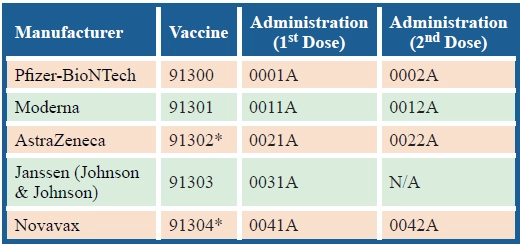Medicare Compliance & Reimbursement
Prepare for This 99211 Revision Effective Jan. 1
Plus: See the latest ‘new’ COVID codes that aren’t actually new.
With COVID-19 still dominating much of the healthcare landscape, it’s no surprise that CPT® 2022 offers a plethora of new and revised COVID-19 codes for you to utilize. What’s even better: many of the codes are already familiar to you, which should make implementing them on Jan. 1 a whole lot easier.
Even so, you still have to make sure you’ve got every detail straight, or your claim may land in limbo. Review these additions and revisions to help you sharpen your procedure coding as we move toward 2022.

Don’t Minimize This Office/Outpatient E/M Change
One immediate change is the deletion of the words “usually, the presenting problem(s) are minimal” from 99211, which will read Office or other outpatient visit for the evaluation and management of an established patient, that may not require the presence of a physician or other qualified healthcare professional when the change takes effect on Jan. 1, 2022.
“The deletion appears to be an editorial revision to bring the descriptor for 99211 more into line with the rest of the office/ outpatient evaluation and management (E/M) codes (99202- 99215). Prior to 2021, all included a sentence that read, ‘Usually, the presenting problem(s) are....’ Now, they don’t,” says Kent Moore, senior strategist for physician payment at the American Academy of Family Physicians.
But the change goes beyond simply realigning the code to its larger group. “It also removes a potential source of confusion,” as it acknowledges that the severity of the patient’s condition does not determine the E/M level for the service, says Cindy Hughes, CPC, CFPC, consulting editor of Cindy Hughes Consulting in El Dorado, Kansas.
“For instance, 99211 may be reported when a nurse provides education to a newly diagnosed diabetic, but diabetes is by no means a minimal problem,” says Hughes. Here, the service being provided (the education) is low-risk and minimal with little data to be reviewed or analyzed, though the complexity of the condition is possibly higher.
Even so, “99211 still represents an E/M (really an assessment and management) service provided by clinical staff as opposed to a physician or other qualified healthcare professional who may report higher levels of E/M services,” Hughes notes.

Reconsider These Old COVID-19 Tests
CPT® 2022 also introduces numerous new pathology and laboratory codes, such as the Clinical Laboratory Improvement Amendments (CLIA)-waived COVID-19 tests you have already seen:
- 87428 (Infectious agent antigen detection by immunoassay technique, (eg, enzyme immunoassay [EIA], enzyme-linked immunosorbent assay [ELISA], fluorescence immunoassay [FIA], immunochemiluminometric assay [IMCA]) qualitative or semiquantitative; severe acute respiratory syndrome coronavirus (eg, SARS-CoV, SARS-CoV-2 [COVID-19]) and influenza virus types A and B), introduced in November 2020;
- 87636 (Infectious agent detection by nucleic acid (DNA or RNA); severe acute respiratory syndrome coronavirus 2 (SARS-CoV-2) (Coronavirus disease [COVID-19]) and influenza virus types A and B, multiplex amplified probe technique) and 87637 (… severe acute respiratory syndrome coronavirus 2 (SARS-CoV-2) (Coronavirus disease [COVID-19]), influenza virus types A and B, and respiratory syncytial virus, multiplex amplified probe technique), both introduced October 2020; and
- 87811 (Infectious agent antigen detection by immunoassay with direct optical (ie, visual) observation; severe acute respiratory syndrome coronavirus 2 (SARS-CoV-2) (Coronavirus disease [COVID-19])), also introduced in October 2020.
Don’t Forget About These Old Vaccine and Administration Codes
Similarly, all the new CPT® 2022 COVID-19 vaccine administration and vaccine codes are codes that you should already be familiar with as they have been active since they received U.S. Food and Drug Administration (FDA) emergency use status beginning late last year.

*Currently pending FDA approval
Plus: You may be interested in these other vaccines for your Medicare practice that received CPT® codes in July — 90671 (Pneumococcal conjugate vaccine, 15 valent (PCV15), for intramuscular use), which is still awaiting FDA approval; 90677 (Pneumococcal conjugate vaccine, 20 valent (PCV20), for intramuscular use); and a new tick-borne encephalitis vaccine 90626 (Tick-borne encephalitis virus vaccine, inactivated; 0.25 mL dosage, for intramuscular use) and 90627 (… 0.5 mL …), which is awaiting FDA approval. Also notable is a brand-new Hepatitis B vaccine: 90759 (Hepatitis B vaccine (HepB), 3-antigen (S, Pre-S1, Pre-S2), 10 mcg dosage, 3 dose schedule, for intramuscular use), which is awaiting FDA approval, too.
Medicare Compliance & Reimbursement
- Billing:
Feds Release Second Part of Surprise Billing Regs
Know the facts on new patient notification requirements. You may have thought the feds would [...] - CPT® 2022:
Prepare for This 99211 Revision Effective Jan. 1
Plus: See the latest ‘new’ COVID codes that aren’t actually new. With COVID-19 still dominating [...] - Compliance:
Nursing Homes, SNFs Sit Atop OIG’s Target List
Latest report focuses on the importance of infection control. Nursing homes and skilled nursing facilities [...] - Reader Questions:
Know the Facts on Timely Filing Extensions
Question: At our practice, we are very careful to submit our Medicare fee-for-service (FFS) claims within [...] - Reader Questions:
Don’t Shirk on Medical Device Management
Question: We monitor many of our Medicare beneficiaries through medical devices, particularly patients struggling with chronic [...] - Industry Notes:
Send Your Medicare Appeals to the Right Place
If your appeals seem to be stuck in traffic, you may be sending them in [...] - Industry Notes:
CMS Updates QPP Resource Library With Fresh Guidance
If you have questions about the Quality Payment Program (QPP), the Centers for Medicare & [...] - Industry Notes:
MAC Offers Due Date Insight for Revalidation Quandaries
Now that Medicare revalidation is back in action, you may want to check and see [...]

